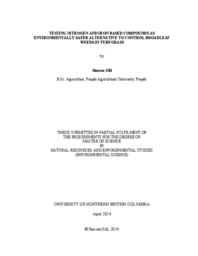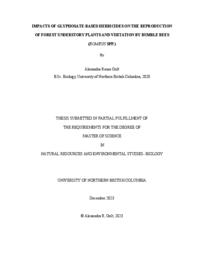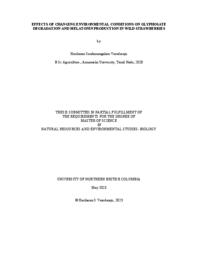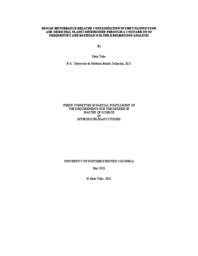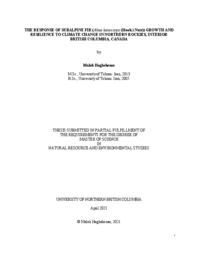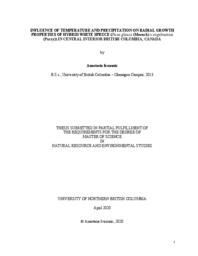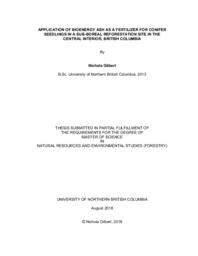Wood, Lisa
Person Preferred Name
Lisa Wood
Related Works
Content type
Digital Document
Origin Information
Content type
Digital Document
Origin Information
Content type
Digital Document
Origin Information
Content type
Digital Document
Description / Synopsis
Turfgrass is an important component of urban and rural lawns and landscapes. However, broadleaf weeds such as dandelions (Taraxacum officinale Weber ex. F.H. Wigg) and white clovers (Trifolium repens L.) pose major challenges to the health and aesthetics of turfgrass fields. Traditional chemical weed control methods, such as 2,4-dichlorophenoxyacetic acid (2,4-D) herbicides, are commonly used, but their safety and environmental impacts are contentious. Seeking environmentally friendly alternatives, this research investigated the effectiveness of nitrogen and iron compounds as nutrient management methods for weed control. In a two-phase experiment; the first was conducted on a mix of cool season turfgrasses (included perennial ryegrass (Lolium perenne L.), Kentucky bluegrass (Poa pratensis L.) and creeping red fescue (Festuca rubra L.)) grown in plastic containers under controlled conditions in the greenhouse. The treatment application included individual nitrogen (1 = urea and 2 = ammonium sulphate) and iron (3 = chelated iron and 4 = iron sulphate) compounds and their combinations (5 = urea × chelated iron, 6 = urea × iron sulphate, 7 = ammonium sulphate × chelated iron, 8 = ammonium sulphate × iron sulphate) contrasted with 9 = a conventional synthetic herbicide (Killex) and a 10 = control (no application) treatment. Weekly assessments over a 12-week period revealed that the combination of ammonium sulphate × iron sulphate had overall best results for weed control and turfgrass quality indicators, and thus was the most effective in inhibiting the growth of dandelions and white clovers while improving the health of turfgrass. The second part, following the greenhouse studies, tested the efficacy of the ammonium sulphate × iron sulphate treatment versus Killex and a control (no application) treatment under natural open environmental conditions at two sites (site 1: no shade vs. site 2: partial shade) with existing broadleaf weeds. The ammonium sulphate × iron sulphate treatment combination resulted in significant reduction in weed cover (66% and 33% in sites 1 and 2, respectively) as well as yielded superior turfgrass quality (based on visual quality ratings and photosynthetic capacity recorded) as compared to both Killex and the control treatments. Overall, the results of this research demonstrate that the combination of ammonium sulphate × iron sulphate is a promising nutrient management solution capable of achieving both aesthetic goals of weed control and turfgrass quality.
Origin Information
Content type
Digital Document
Description / Synopsis
Glyphosate is the active ingredient in many common broad-spectrum herbicides used in forestry operations to reduce the presence of unwanted, competitive plant species. As a result of aerial applications, non-target forest understory plants receive a sublethal dose of glyphosate-based herbicides (GBH) and develop abnormalities such as changes in reproductive morphology. Glyphosate inhibits the enzyme 5-enolpyruvylshikimate-3-phosphate synthase (EPSPS) of the shikimate pathway which produces the crucial aromatic amino acids for plant growth and other biochemical processes. There is very limited information on the long-term impacts of GBH on forest understory plant reproduction, fruit production, and vegetation production. Additionally, there are limited resources that discuss the impacts of GBH on the detection and visitation by bumble bees (Bombus spp.). The objectives of this research were to: 1) quantify glyphosate residues present in Chamaenerion angustifolium flowers and in samples of Bombus spp. found in areas treated with GBH; 2) quantify and compare stamen fluorescence of C. angustifolium (fireweed) flowers from GBH treated and untreated areas in operational forestry settings; 3) quantify the abundance and occurrence of different Bombus spp. in cutblocks one- and two-years post application compared to control sites; 4) quantify and compare the visitation of C. angustifolium by Bombus spp. in glyphosate-based herbicides treated and untreated plants; and 5) quantify and compare pollen viability, leaf-out, and fruit production in a variety of important food-producing forest plants in glyphosate-based herbicide treated and untreated sites in operational settings. I found that the amount of glyphosate residue present in floral tissues remained similar between one- and two-years post treatment. I also found that glyphosate-based herbicides have an impact on the fluorescence of male reproductive structures of forest understory plants. There was a reduction in the fluorescence emission of blue spectral wavelengths of anthers and pollen due to glyphosate-based herbicide treatment could lead to a reduction in detection and visitation by bumble bees as the blue photoreceptor in their compound eyes will be less likely to detect a flower for the bee to be drawn to it. Additionally, the increase in hue and saturation indicates that the presentation of the dominant wavelength present may no longer be the blue spectral wavelength. My findings indicate that glyphosate-based herbicides do not have an impact on the amount of time an individual bumble bee spends foraging on a flower. Glyphosate treatment influences floral characteristics related to bumble bee detection of flowers during foraging. This affects the number of bees present, but glyphosate-based herbicides do not impact how long an individual bumble bee visits a flower nor foraging effort once they are on a flower. The reduction in pollen viability seen in C. angustifolium one-year post-application is similar to pollen viability seen in control samples by year two after glyphosate-based herbicide applications, indicating that GBH initially have a large impact on pollen quality but there is a recovery in pollen quality in C. angustifolium over time. Lastly, my findings indicate that application of GBH resulted in a reduction of leafout and fruit production of multiple forest plants one-year post-glyphosate treatment. The reality is that GBH may have greater implications on the ecological roles of fruit-producing plants and for the availability of food for animals in forest cutblocks than was previously acknowledged.
Origin Information
Content type
Digital Document
Description / Synopsis
Archaea, a domain of organisms possibly linked to the ancestry of eukarya and bacteria, displays a dichotomic evolutionary pattern. Haloarcula marismortui (H. marismortui), an archaeon discovered in the Dead Sea, has unique traits enabling survival and thriving in hypersaline environments. Research in this study includes investigating the Trk potassium transport system, which may contribute to stability of this archaeon in varying extreme environmental conditions. A primary focus on the TrkE protein role in the system, also known as SapD , which in Haloarcula marismortui is OppD1. The Trk system has been studied in several species, and through each it has been consistently found to be homologous to the E. coli sapABCDF operon, which has been found to encode an ABC transporter. Within this operon in E. coli TrkE is coded for by the SapD gene. The goal of this study was to clone the TrkE homolog from Haloarcula marismortui and continue with further research into the characterization of the protein to aid in the prediction of its overall function in potassium transport. Data in this study strongly suggest the size of the H. marismortui homolog of TrkE, OppD1, is larger than its E.coli homolog by approximately 10,000 Daltons. Further analysis also identified that the mainly alpha-helical protein has a significant sequence identity with SapD. Future considerations include looking at the purpose of the N-terminal extended region of OppD1 not seen in SapD, and further analyzing OppD1 for structure changes in varying salt conditions and possible binding partners. The exceptional survival skills of H. marismortui in high-salinity environments, possibly facilitated by the Trk system, make it an excellent model for studying halophiles. These insights offer valuable understanding into how halophiles maintain cellular integrity under harsh conditions, especially regarding OppD1's potential role within the Trk system for ion transport and osmotic regulation in different environmental settings.
Origin Information
Content type
Digital Document
Description / Synopsis
Glyphosate is a broad-spectrum herbicide commonly used in Canadian forests to control competitive vegetation. The non target plant species are exposed to a sublethal dose of glyphosate-based herbicides (GBH) due to aerial applications that cause deformities along with other potentially unknown effects. The efficiency and degradation of glyphosate to its metabolic by-products, including amino-methyl phosphonic acid (AMPA), are based on environmental conditions and the genetic capabilities of the plant or exposed organism. Glyphosate enters the plant through foliage and blocks the production of aromatic amino acids such as tryptophan by inhibiting the plant enzyme 5-enolpyruvylshikimate-3-phosphate synthase (EPSPS). Interestingly, the amino acid tryptophan acts as the precursor of the plant stress response hormone called melatonin. Whenever a plant is exposed to biotic or abiotic stress, the level of melatonin increases to protect the plant. The production of melatonin also tends to change depending on the environmental conditions. Glyphosate-based herbicides may act as a chemical stress, and the plants may respond to it by increasing melatonin concentration. The objectives of this research were: 1)To find out how environment, in this case, measured by the effects of the combination of temperature and photoperiod, affect plant stress responses to GBH application, and to determine which combination of temperature and lightsupported the faster degradation of glyphosate to its secondary metabolite AMPA; 2) To determine the effects of changing environmental conditions and GBH application on a plant’s melatonin production. I used wild strawberries (Fragaria virginiana) as my experimental species as they are a common understory species grown in the forest areas of British Columbia, Canada, where GBH is sprayed, and are also of importance as food to humans and wildlife. I used 1080 g/m2 of GBH treatments in my experiment to replicate the sublethal dose received by the non-target plants in industrial operations. Several plant stress responses were observed during the measurement period in three different trials. Trial 1 had different temperatures with constant photoperiod, trial 2 had different photoperiods with constant temperature, and trial 3 combined variation in temperature and photoperiod. At the end of experiment, I found that GBH were highly effective at 20°C with 18 hours of photoperiod as it affected several plant morphological features. The degradation of GBH were maximum at 20°C with 24 hours of photoperiod as suggested by the degradation ratio of glyphosate and AMPA. The new leaves produced by the plants after GBH application were more sensitive to glyphosate as leaf area and photosynthetic capacity by the new leaves were severely affected compared to the previously emerged leaves. Melatonin levels were altered by temperature, week of sample collection and slightly by photoperiod. The production was not affected by GBH application. These results suggest that wild strawberries grown in forest areas with warmer temperatures are most highly affected by glyphosate applications and when warm temperatures are accompanied by longer duration of sunlight, faster degradation of glyphosate is facilitated in tissues.
Origin Information
Content type
Digital Document
Description / Synopsis
Increased development in forestry, oil and gas, road infrastructure, and agriculture sectors across the Swan River Watershed (Alberta, Canada) has led to an increase in the impact they have on the riparian and aquatic ecosystems. These industries require the removal of vegetation for construction and operation, and some do not require buffer zones around waterbodies to protect aquatic habitat. These industries also use herbicides and fertilizers that may contain high levels of heavy metals, as well as glyphosate. In this thesis, I examined the changes to abundance of plant species chosen by Knowledge Keepers of the Swan River First Nation, as well as general plant categories (i.e., shrub, trees, and herbaceous), in relation to industrial development. I also examined how heavy metal and glyphosate content changed in these plant species with distance from industrial development. Sixty-seven sites were sampled across the Swan River Watershed, each with seven transects examining plant abundance. Tissue samples of chosen species were collected on the first, fourth, and seventh transects. I found significant ( = 0.05) changes to the abundance of aquatic and riparian plant species and categories in association with industrial activity. I also found significant ( = 0.05) changes to heavy metal concentrations in response to industrial presence and distance. There was a significant ( = 0.05) increase in the presence of glyphosate in plant species when forestry or agriculture were present at a site. These results were obtained after conducting a comparison of multiple Bayesian and frequentist regression analysis. There has been an increased interest in Bayesian analysis in ecology, however there is still some hesitation around its implementation due to hardware and software costs, time, and education. The Bayesian method resulted in smaller root-mean-squared-errors and increased precision. I also found that the time and costs were the same as the frequentist analysis, when using a dataset collected over one field season. The biggest barrier in the implementation of Bayesian analysis was the lack of accessible education through formal university courses.
Origin Information
Content type
Digital Document
Description / Synopsis
Glyphosate-based herbicides (GBH) are highly effective, nonselective herbicides that have been used in British Columbia’s forest industry since the early 1980s to remove deciduous vegetation competing with commercially important coniferous tree seedlings. Long term persistence of glyphosate and its metabolic byproduct aminomethylphosphonic acid (AMPA) in the forest ecosystem has not previously been monitored beyond one year, although it is known that glyphosate may be stored in tissues of plants that received a sublethal dose of GBH. The primary objective of this research thesis was to determine the duration (up to twelve years) of glyphosate and AMPA persistence in the roots, shoots, and fruits of selected perennial plant species in GBH-treated forest cutblocks. Due to the ability of glyphosate to form insoluble complexes with metal ions, it was suspected that metal nutrient concentrations in surviving plants might be affected by persistent glyphosate. The second main objective of this thesis was to determine if concentrations of calcium (Ca), iron (Fe), magnesium (Mg), manganese (Mn), nickel (Ni) and zinc (Zn) were significantly altered by GBH treatment. Plant tissue samples from five forest understory perennial species growing in two distinct biogeoclimatic (BEC) zones of northern BC were analyzed for glyphosate and AMPA content, and comparisons were made between species, plant tissue type, and BEC zone. Residues persisted for up to 12 years in some tissue types, and root tissues generally retained glyphosate residues longer than shoot tissue types. Samples from the drier, colder, more northern Boreal White and Black Spruce (BWBS) BEC zone retained significantly higher levels of glyphosate for longer than samples collected from the warmer Sub-Boreal Spruce (SBS) BEC zone. Shoot samples from three species in the SBS zone were further analyzed for nutrient contents. Nutrient concentrations were more variable over time in treated samples than in control samples, and comparison of treated and control samples resulted in significant differences in 47 % of all cases, and in 61 % of year one samples. Generally, Ca, Mg and Ni decreased with treatment in all three species; Zn increased with treatment for each species; and Fe and Mn had inconsistent changes with treatment. Both the persistence of glyphosate and related changes in plant nutrient concentrations may have cumulative health effects for wildlife. More research should be conducted in this field, as many questions remain unanswered.
Origin Information
Content type
Digital Document
Description / Synopsis
Understanding forest growth and resilience under global climate change is crucial for forest management, to maintain wood supply for future. In this research, I focused on the response and resilience of subalpine fir (Abies lasiocarpa (Hook.) Nut)) growth to climate variables and severe drought events at five stands located along northern slopes of the Rockies in northern BC, Canada. Results revealed that temperature (especially summer and previous fall) was the most important climate factor controlling growth of subalpine fir trees at study sites. The lower the latitude, the more summer temperature negatively effected tree growth. Also, results showed that subalpine fir trees were resilient to very dry conditions at study sites, when considering the growth recovery period to drought was between 1 to 2 years. The lower the latitude, the faster the trees recovered from drought. However, subalpine fir trees located at higher latitudes were more resistant to the effects of drought.
Origin Information
Content type
Digital Document
Description / Synopsis
I evaluated how intra- and inter-specific competition affects the development of eleven wood attributes of trembling aspen (Populus tremuloides Michx.) and white spruce (Picea glauca (Moench) Voss) over 34 years. My analysis was conducted in a mixedwood trial site in Northern British Columbia, Canada, that included treatments consisting of 0, 1000, 2000, 5000, and 10000 stems per hectare of aspen. Competition was found to negatively influence wood attribute development in aspen and positively impact spruce (at low levels of competition). Plot level competition indices were the best predictor of variation in aspen wood attributes, while stand level competition (population density) best explained the majority of spruce wood attributes. Maintaining aspen at lower densities in intimate mixture can have a positive effect on spruce wood quality, while incurring relatively small reductions in spruce volume production and also retaining the ecological benefits associated with managing for mixed stands.
Origin Information
Content type
Digital Document
Description / Synopsis
It is prudent to understand how changes in climate will affect tree-ring growth, wood fibre quality, and percent carbon content in natural and planted stands in central interior British Columbia (BC), as BC produces high volumes of wood fibres that are competitive in a global market. Wood properties within natural and planted stands of hybrid white spruce (Picea glauca (Moench) x engelmannii (Parry)) (percent carbon, ring-width, earlywood and latewood width and wood cell properties of cell wall thickness, density, microfibril angle, radial diameter and coarseness) were assessed to determine if climate variation is a limiting growth factor. Results show precipitation is an important limiting factor in planted stand growth with some indication that increasing temperatures limit growth in natural stands. Relationships between climate and percent carbon indicate that rising winter, spring, and summer temperatures coupled with reduced precipitation strongly limit percent carbon accumulation in most natural and planted stands.
Origin Information
Content type
Digital Document
Origin Information
Content type
Digital Document
Origin Information




